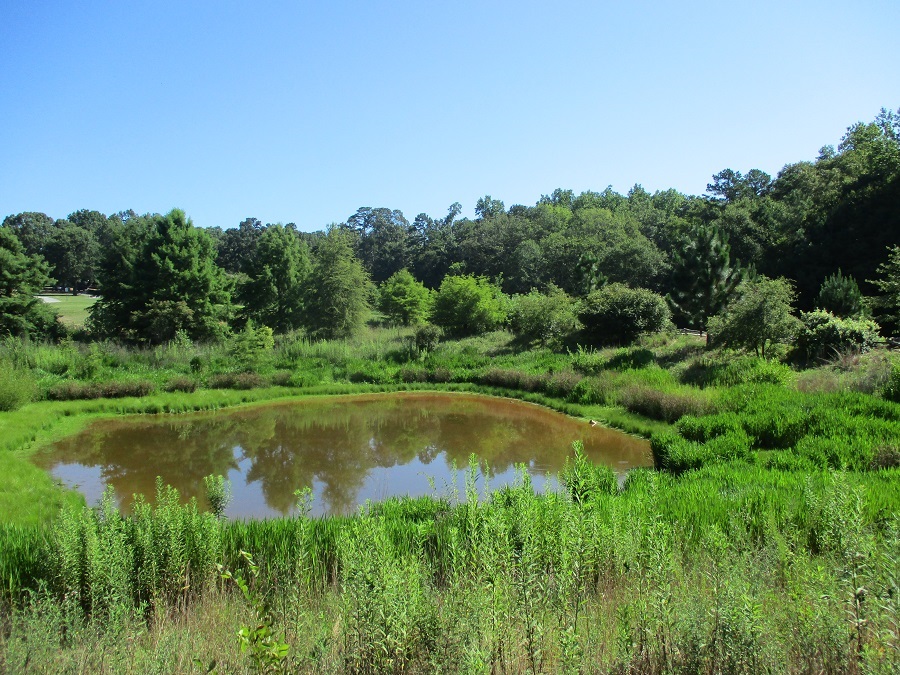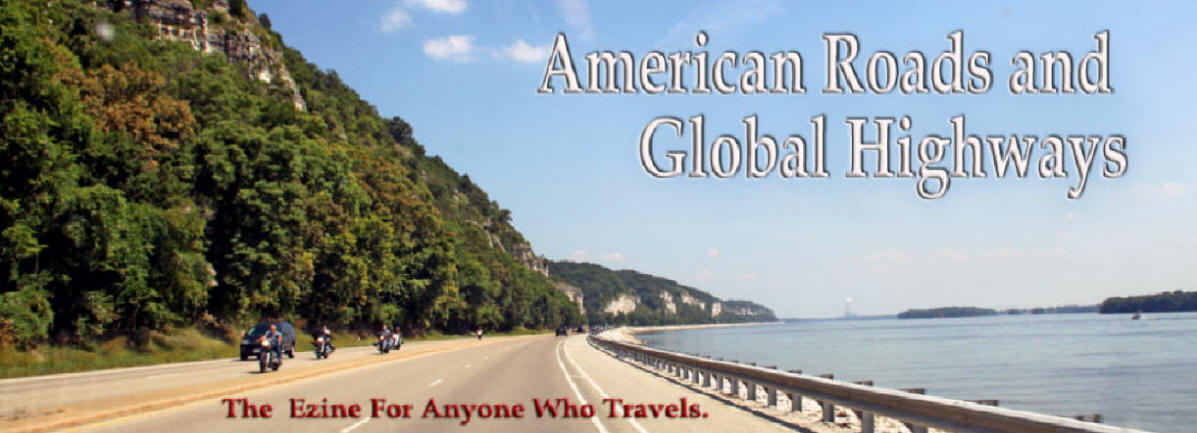|
There are many
interesting historical and natural attraction
located just a few miles off the interstate; one
is a fantastic botanical garden just ten miles
from the exit on Interstate 85, halfway between
Atlanta and Charlotte. It is Clemson
University’s South Carolina Botanical Garden,
which is much more than the standard botanical
garden. All the traditional plant-focused things
are there, but a lot more, like a special
natural heritage trail that allows the visitor
to transect the natural plant habitats of the
state in just a half-mile. After “walking across
the state,” you can see the largest outdoor
desert in the eastern United States, a hosta
garden with nearly 400 species, and a thriving
camellia garden where the botanical garden got
its start. Plus, almost all of it is
out-of-doors and all the out-of-doors
attractions are open during the pandemic.
A Focal Point
of the Garden
About ten years
ago the botanical garden was transformed from a
collection of plants to something broader that
represented the state’s “history, culture,
geography, climate, or people.” The focal
point of that transformation is the 64-acre
Natural Heritage Garden, a half-mile walking
tour that includes the major natural habitats
you’d encounter if your walked from South
Carolina’s coast to its mountains.
Rather than
growing plants from different part of the state,
the garden is a series of mini-ecosystems or
complete natural habitats. If you start at the
coast with the maritime forest, for example,
you’ll walk through the same habitat that the
earliest European settlers confronted, including
live oaks, sabal palmettos, sweetgrass, and
yaupon hollies. The idea is to tell the South
Carolina story, including palmettos that
protected Fort Moultrie or sweetgrass used to
make the Gullah baskets sold in the Charleston
markets.
 |
| As you enter the Nature Heritage
Trail you’ll see the plants you’d expect
right at the coast, including the state
tree. |
The habitats were
created by moving material from various parts of
the state to the garden: rocks from granite
outcrops in Lancaster County, soil from the
sandhills to recreate the piedmont, and hundreds
of native plants used to create the mountain
meadow in the Appalachian cove forest.
Structures are built into the trails to give the
illusion you are traveling across the state,
like bridges over mountain steams or a boardwalk
through coastal sand dunes.
 |
| The trail
begins with the Maritime Forest,
including palmettos. |
The Natural
Heritage Garden Trail can be accessed from both
the foothills and coastal ends. Starting from
the coastal end, the main features on the trail
include:
 |
| Portion
of Native American Shell Ring. |
The trail begins
where sea meets the coast, the maritime forest
on South Carolina’s sea islands, with palmetto
trees and lives oaks with hanging Spanish moss.
Near the coast you might also find rare Native
American shell rings or middens (mounds). These
are 4,000-5,000 years old and were constructed
with massive amounts of oyster shells. They can
be huge, up to 200 feet in diameter and impact
the nearby plant distribution. Oyster shells
contain calcium carbonate, which like lime makes
the soil basic, allowing trees such as sugar
maple and basswood to grow “out of place.”
You’ll see part of a shell ring on the trail and
even a coastal bog near the maritime forest.
Just inland along the Atlantic Coast, mainly in
the Carolinas and Georgia, are Carolina bays,
elliptical depressions mostly oriented in a
northwest-southeast direction. These are
isolated wetlands that are threatened as
development and agriculture claim them. Large
ones can be several thousand acres in size. Most
are much smaller than that and there is a small
one on the trail. At one spot is a collection of
carnivorous or insectivorous plants, like
sundews, pitcher plants, and Venus flytraps.
 |
| What
you’d expect in moist areas of the lower
coastal plain, some carnivorous plants. |
Moving further
inland, you’ll see the longleaf pine savanna,
originally a major forest type of the coastal
plain. It requires a fire ecology (frequent
burning), is highly diverse, and that diversity
includes lots of wildflowers. This forest was a
major source of lumber and naval stores. Naval
stores were produced from longleaf pine resin,
like turpentine. Tar and pitch products were
used to seal wooden ships, hence the name.
 |
| Longleaf
Pine on the sandhills. |
Along the trail is
a streamhead pocosin. Pocosin is a Native
American term for “swamp-on-a hill.” Unlike the
nearby sandhills and savanna forests, the
pocosin soil is deep, nutrient poor, and acidic.
They support evergreen plants such as holly,
sweetbay, magnolia, and loblolly bay.
 |
| Granite
outcropping where the Piedmont starts. |
When the sandhills
transition to the Piedmont, there are rocks.
Granite comes to the surface. Wide expanses of
granite outcrops create mesic or very dry
conditions and plants with desert-like adaptions
appear. At one time huge herds of bison and elk
grazed on a grassland in the Piedmont of South
Carolina. The trail has a ten-acre patch of
Piedmont prairie, along with prairie
wildflowers.
|

A streamhead pocosin, the beginnings of
a wetlands.
|
 |
| A Piedmont
prairie, all that is needed are some
bison. |
 |
| A small
Carolina bay. |
The trail leads towards the
foothills and an oak-hickory forest appears.
Things cool off as you move from the prairie to
the thick sheltering forests. The oak-hickory
forest in the Upstate of South Carolina is a
relatively new natural succession, which
resulted when fire suppression on the prairie
and savanna created by Native American fires
decreased, allowing for a new forest. There are
plenty of signs of squirrels in this forest, as
this is one of their favorite habitats.
 |
| The oak-hickory
forest. |
 |
| The basic mesic
forest. |
Next on the trail is a basic mesic forest
(mesic means moderate amounts of water). It is a
rarer forest of the Piedmont, appearing on
fire-sheltered slopes along major rivers.
Finally, there is the cove forest, representing
the southern Appalachians. This is the forest
you’d find in the nearby Jocassee Gorge. The
cove forest is a small part of South Carolina,
but one with some of its plant greatest
biodiversity.
 |
| The cove
forest. |
Rest of the
Garden
 |
| Flower display
garden. |
Most people would
have started with the more traditional botanical
garden features, like the multitude of
demonstration gardens on the property. These are
not small display areas; they are widely
dispersed across the garden; and most require
long sub-paths off the main path, as they are
integrated into the landscape. Included is a
hosta garden, camellia garden, wildlife habitat
garden, xeriscape garden, picnic garden, dwarf
conifer garden, hydrangea garden, perennial
garden, and a desert garden.
 |
| Desert garden. |
 |
| Dwarf conifer
garden. |
 |
| Xeriscape
garden. |
The trail system
is high quality and well-maintained, with many
trails being hard-surfaced. Beautiful streams
weave through the garden and there are small
ponds (including a duck pond, where you can feed
ducks and geese).
| |
|

A typical
path in the garden.
|
The garden has more than plants. Two
historical houses are on the property. The
Hanover House was built in 1716 and was moved to
the garden from South Carolina’s Lowcountry. It
is listed on the National Register of National
Places. The second house is the Hunt Cabin,
built in 1826, and moved to the garden from an
adjacent county.
 |
| Hunt Cabin, one
of two historic homes on the Garden. |
The garden is kid-friendly, and there are
some kid-focused attractions like a caboose near
the main parking lot. There is a visitor’s
center and a geology museum. The museum has an
extensive collection of gems, minerals, and
fossils of the region, and includes an elaborate
fluorescent mineral display room and has the
only saber-toothed cat exhibit in the Southeast.
 |
| A caboose
located near the parking lot, one of
many attractions that will interest the
kids. |
One of the largest
collections of nature-based sculptures in the
country, built only with natural materials, such
as stone and plant material, is displayed across
the garden. The sculptures are scattered across
the property and must be discovered while
walking the trails.
 |
| The “Crucible,”
one of the nature-based sculptures,
located on the cove forest end of the
nature heritage trail. |
You can easily
spend a day at the garden. There are gems hidden
throughout the 295 acres, like a 70-acre
arboretum and those nature-based sculptures you
have to discover. It is very family friendly,
with a planned children’s garden, including a
canopy walk through the treetops, a botanical
maze, and a water garden among its kid-friendly
features. An earlier article in this Ezine
featured another great attraction only two miles
away: John C. Calhoun’s Fort Hill Plantationpan>.
So, it is possible to get a dose of regular
history and natural history all in the same day
at nearly the same location, and have a lot of
fun too.
Author:
Thomas J. Straka is a forestry professor at
Clemson University. He has a keen interest in
political and natural history.
For additional
information:
About South Carolina
Botanical Garden
https://www.clemson.edu/public/scbg/about-us/index.html
Natural Heritage
Garden Trail
https://www.clemson.edu/public/scbg/natural-heritage-garden/index.htm
|




















